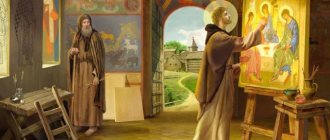The Old Testament: composition of books, history of creation. The place of the Bible in the history of religion.
The Old Testament is the first and oldest of the two (along with the New Testament), part of the Christian Bible, the ancient Jewish Holy Scripture ("Hebrew Bible"), the common sacred text of Judaism and Christianity. The books of the Old Testament were written between the 13th and 1st centuries. BC e. in Hebrew, with the exception of some parts of the books of Daniel and Ezra, which are written in Aramaic. In the period from the 3rd century. BC e. to the 1st century n. e. The Old Testament was translated into ancient Greek. The text of the Old Testament has reached us in many ancient and medieval manuscripts used in modern editions. These include texts in Hebrew and ancient translations, of which the most important are the Septuagint, a translation into ancient Greek made in Alexandria at the end of the first millennium BC. e., Vulgate - translation into Latin made by Jerome in the 5th century AD. e., Targums - translations into Aramaic and Peshitta - translation into Syriac, made among early Christians in the 2nd century AD. e. Among the manuscripts in Hebrew, an important place is occupied by the medieval manuscripts of the Masoretic text - the official text of Judaism, among which the Leningrad and Aleppo codes are considered the most authoritative. The most ancient sources of the text of the Old Testament are the Qumran manuscripts, which contain fragments of all the books of the Old Testament, with the exception of the books of Esther and Nehemiah, as well as the complete text of the book of the prophet Isaiah. An important place among the sources of the Old Testament is occupied by the Samaritan Pentateuch - the Hebrew text of the Pentateuch, written down in one of the varieties of Paleo-Hebrew writing (Samaritan letter) and preserved by the Samaritan community. Church Slavonic translations of the Old Testament - the Gennadian Bible, the Ostrog Bible and the Elizabethan Bible - were carried out from the Septuagint. Modern Russian translations - the Synodal translation and the translation of the Russian Bible Society are made on the basis of the Masoretic text. This translation (the Septuagint) was adopted by the first Christians and played an important role in the formation of the Christian canon of the Old Testament.
The Canon of the Old Testament is a set of Old Testament books recognized by the Church as divinely inspired. Currently, there are three canons of the Old Testament, differing in composition and origin: the Jewish canon (Tanakh), formed BC. e. in Judaism; The Christian canon, based on the Alexandrian version of the corpus of sacred texts of Judaism (Septuagint) and accepted in the Orthodox and Catholic Churches; A Protestant canon that emerged in the 16th century and occupies an intermediate position between the first two.
The Jewish canon is divided into three parts in accordance with the genre and time of writing of certain books.
Law or Torah, including the Pentateuch of Moses
Prophets or Neviim, which includes, in addition to the prophetic, some books that today are considered to be historical chronicles.
Nevi'im are divided, in turn, into three sections.
Ancient Prophets: Books of Joshua, Judges, 1 and 2 Samuel (1 and 2 Samuel) and 1 and 2 Kings (3 and 4 Kings)
The later prophets, including 3 books of the “major prophets” (Isaiah, Jeremiah and Ezekiel) and 12 “minor prophets”. In the manuscripts, the “minor prophets” made up one scroll and were considered one book.
Attention!
If you need help writing a paper, we recommend turning to professionals. More than 70,000 authors are ready to help you right now. Free adjustments and improvements. Find out the cost of your work.
Cost calculationGuaranteesReviews
Scriptures or Ketuvim, including the writings of the sages of Israel and prayer poetry.
Ketuvim includes a collection of “five scrolls”, including the books Song of Songs, Ruth, Lamentations, Ecclesiastes and Esther, collected in accordance with the annual cycle of readings in the synagogue.
Conventionally, the books of Judges and Ruth, Jeremiah and Lamentations, Jeremiah, Ezra and Nehemiah are considered in pairs as one book by a common author, so that the total number of books of the Tanakh is equal to 22, according to the number of letters of the Hebrew alphabet. Many ancient authors count 24 books in the Tanakh. All books of the Jewish canon were originally generally accepted in all Christian communities.
The Alexandrian Canon of the Old Testament (Septuagint) was adopted at the turn of our era by the Jews of Alexandria and formed the basis of the Christian canon of the Old Testament (this applies to both the text and the composition and rubrication of books). It differs markedly from the Jewish Tanakh both in the composition of the books and in their arrangement and individual texts. It must be borne in mind that textually the Alexandrian canon is based on a different, non-proto-Masoretic version of the original text. It also cannot be ruled out that the additions in it may be of Christian origin. After the destruction of the Second Temple, the Alexandrian canon was not accepted by Judaism and was preserved only in lists of Christian origin. Structurally, the Alexandrian canon differs in that the books of Neviim and Ketuvim are redistributed between sections in accordance with a different idea of genres than in the Tanakh. These are 39 books, which represent the following sections:
Books of the Law (Pentateuch) (Genesis-Deuteronomy)
Historical books (Book of Joshua-Esther)
Educational (poetic) books (Book of Job - Book of Proverbs of Solomon - Book of Ecclesiastes)
Prophetic books (Book of the prophet Isaiah-Book of the prophet Malachi)
Protestant canon
During the Reformation, the dominant Western understanding of the canonicity and authority of biblical books underwent a radical revision. Jacob van Liesveldt in 1526 and Martin Luther in 1534 published Bibles in which only the books of the Jewish canon were included in the Old Testament. Books not included in the Jewish canon receive the name apocrypha in the Protestant tradition - a term assigned in the Eastern Christian tradition to late (2nd century BC - 1st century AD) literature that was never included in the Alexandrian and Christian canons.
We will help you write any paper on a similar topic.
- Essay
The Old Testament: composition of books, history of creation. The place of the Bible in the history of religion.
From 250 rub.
- Test
The Old Testament: composition of books, history of creation. The place of the Bible in the history of religion.
From 250 rub.
- Course work
The Old Testament: composition of books, history of creation. The place of the Bible in the history of religion.
From 700 rub.
Receive completed work or specialist advice on your educational project
Find out the cost





